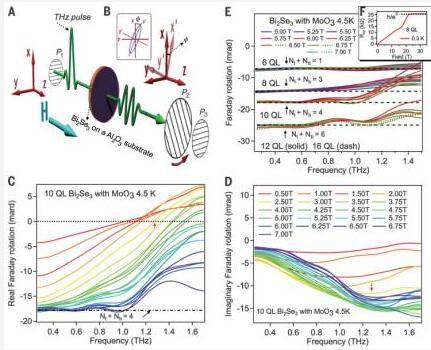Abstract 1. Multiple nanostructures based onanodized aluminium oxide templates
1. A variety of nano-microstructures based on alumina templates
(Multiple nanostructures based on anodized aluminium oxide templates)
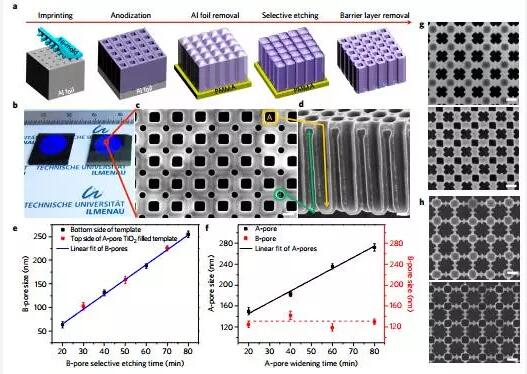
The concentrated physicochemical effects and properties in solid matter involve the interaction of adjacent materials and morphologies. Bimetallic nanostructure arrays are capable of integrating interactions between different subcomponents, but the preparation of such bimetallic nanostructures remains highly challenging. Wen et al. proposed a method for synthesizing a variety of bimetallic structures, and this method is highly controllable for subcomponents, including materials, dimensions, and topography. This bimetallic nanostructure concept is derived from a two-hole anodized aluminum template, i.e., having two sets of pore structures on a matrix that open in different directions. Using this growth mechanism, this two-hole template can be extended to porous templates. They also demonstrated that the use of such a two-hole template for the fabrication of photoelectrodes, effect transistors, and plasma devices exhibits better performance than single-component devices. (Nature Nanotechnology DOI: 10.1038/NNANO.2016.257)
2. Double redox ionic liquid for high specific energy supercapacitors
(Biredox ionic liquids with solid-like redox density in the liquid state for high-energy supercapacitors)
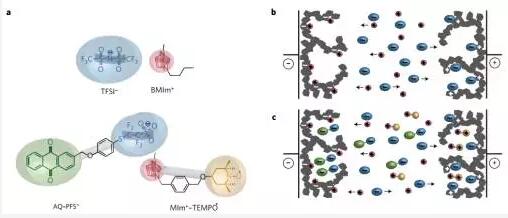
Since solids are much less reactive than liquids, the kinetics of electrochemical reactions are several orders of magnitude slower in solids than in liquids. However, the solid state maximizes the density of the redox species, which is at least two orders of magnitude lower in the liquid due to solubility limitations. For electrochemical energy storage devices, high energy density batteries have only a limited power density, while high power supercapacitors have a lower energy density. For such devices, an ideal system should impart a near-solid redox species density to the liquid state. Olivier Fontaine et al. describe a method for achieving redox density of solid-like materials in the case of fast liquid-like kinetics based on a biredox ionic liquid. The cations and anions in the bisoxidation ionic liquid bear the part of the fast reversible redox reaction. In order to demonstrate their potential for high-capacity/high-rate charge storage, Olivier Fontaine et al. demonstrated their use in redox supercapacitors. These ionic liquids are capable of decoupling charge storage from the surface of the electrode through which ions are stored by storing a large amount of charge in the pores of the electrode, thereby minimizing self-discharge and leakage current due to retention of the redox species in the pores, and They have a wider electrochemical window to increase the operating voltage. (Nature Materials DOI: 10.1038/NMAT4808)
3. Fluorescent nanodiamond tracking reveals abnormal transmission in neurons
(Fluorescent nanodiamond tracking reveals intraneuronal transport abnormalities induced by brain-disease-related genetic risk factors)

Brain diseases such as autism and Alzheimer's disease (each accounting for more than 1% of the world's population) involve large networks that show subtle changes in gene expression. It has been found that intra-neuronal transmission abnormalities are associated with genetic risk factors found in patients, which also indicates a correlation with the measurement of this critical biological process. However, current techniques are not sensitive enough to detect small anomalies. Simon Haziza et al. proposed a sensitive method for measuring changes in intracellular transmission induced by genetic risk factors associated with brain diseases using fluorescent nanodiamonds (FND). The results showed that high brightness, photostability and no cytotoxicity allowed FND to be tracked within the dissociated neuron branches with a spatial resolution of 12 nm and a time resolution of 50 ms. They used FND to perform follow-up measurements in two transgenic mice, simulating a slight change in protein concentration (about 30%) found in the patient's brain, as evidenced by the principle. The results show that in both cases, the FND sensitivity is sufficient to measure these changes. (Nature Nanotechnology DOI: 10.1038/NNANO.2016.260)
4. Observation of the extreme phase transition temperature of water confined in a single carbon nanotube
(Observation of extreme phase transition temperatures of water confined inside isolated carbon nanotubes)

It has been predicted that the fluid phase transition in a single, isolated carbon nanotube is substantially deviated from classical thermodynamics. This property enables the study of ice nanotubes and explores their potential applications. Michael S. Strano et al. demonstrated the use of Raman spectroscopy to limit the phase boundaries of water in six isolated carbon nanotubes of different diameters (1.05, 1.06, 1.15, 1.24, 1.44, and 1.52 nm). The results show that the freeze transition is extremely sensitive to diameter and the temperature rise (up to 100 ° C) is greater than theoretically predicted. Moreover, dynamic water-filling and reversible freezing transitions were marked at 2-5 cm-1 in the radial breathing mode frequency. For 1.05 and 1.06 nm single-walled carbon nanotubes, the reversible melting was 105-151 °C and 87-117 °C, respectively. Within the 1.44 and 1.52 nm nanotubes, near-environmental phase transitions were observed between 15-49 ° C and 3-30 ° C, respectively. In addition, a decrease in freezing point was observed between -35 and 10° for 1.15 nm nanotubes. They also found that the internal aqueous phase reversibly reduced the axial thermal conductivity of the nanotubes by up to 500% and allowed digital control of the heat flux. (Nature Nanotechnology DOI: 10.1038/NNANO.2016.254)
Quantitative Faraday and Kerr Rotation and Axial Electrodynamics of 5.3D Topological Insulators
(Quantized Faraday and Kerr rotation and axion electrodynamics of a 3D topological insulator)
Topological insulators are considered to be good bulk electromagnetic materials and are capable of quantifying their response functions based on fundamental physical constants. Liang Wu et al. reduced the chemical potential of the three-dimensional (3D) Bi2Se3 film to about 30 meV above the Dirac point and used a high-precision time-domain terahertz polarimeter to detect the low-energy electrodynamic response of the current magnetic field. For magnetic fields above 5 Tesla, they observed quantized Faraday and Kerr rotations, while DC transmission is still semi-classical. An important Berry phase shift gives evidence for axial electrodynamic and topological magnetoelectric effects. The time structure used in these measurements allows direct measurement of fine structure constants based on topological invariance of solid state systems. (Science DOI: 10.1126/science.aaf5541)
6. Sliding-activated surface creep in metal nanocrystals
(Slip-activated surface creep with room-temperature super-elongation in metallic nanocrystals)
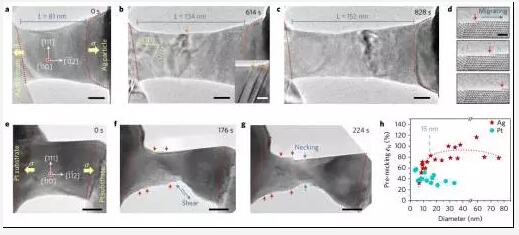
It is now known that nanoscale metal crystals follow the trend of "smaller and stronger". However, they generally exhibit low ductility due to premature plastic instability caused by crystal slip. Now, through atomic-scale in-situ transmission electron microscopy, Mao et al. introduced the softening-free super-elongation of face-centered cubic silver nanocrystals at room temperature, where crystal slip is an activator of surface diffusion creep. Both experiments and theories show that this interaction mechanism controls the plastic deformation of nanocrystals within the diameter range of the material-related sample, which is determined by the surface diffusion creep and the dislocation plasticity of the nanocrystal stability, respectively. Exceeds the maximum size for pure diffusion-mediated deformation (eg Coble type creep). This work provides an understanding of the mechanism of atomic-scale coupled diffusion displacement deformation in nanomaterials while maximizing ductility and strength. (Nature Materials DOI: 10.1038/NMAT4813)
7. Ultra-smooth glassy graphene film
(Ultra-smooth glassy graphene thin films for flexible transparent circuits)
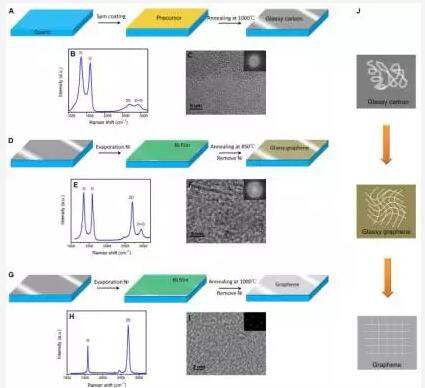
Large-area graphene films are important in deformable transparent devices. Dai et al. proposed a glassy graphene which is in an intermediate state between glassy carbon and graphene and has a crystal plane with high crystallinity and curl. They introduced a polymer-assisted method to grow ultra-smooth (roughness, <0.7 nm) glassy graphene films in inches. Since the glassy graphene film inherits the advantages of graphene and glassy carbon, the glassy graphene film exhibits electrical conductivity, transparency and flexibility comparable to those of graphene, and mechanical and chemical stability of glassy carbon. In addition, a glass-state graphene-based circuit can be fabricated by direct laser drawing, and can be reliably operated after the circuit is transferred to a flexible substrate. Glassy graphene films should be able to stimulate the use of flexible transparent conductive materials in integrated circuits. (Science Advances DOI: 10.1126/sciadv.1601574)
8. Ultra-thin metal organic framework nanosheet electrocatalytic oxygen evolution
(Ultrathin metal–organic framework nanosheets for electrocatalytic oxygen evolution)
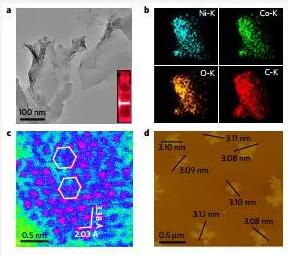
Designing and synthesizing effective electrocatalysts is very important for electrochemical conversion technology. Oxygen evolution (OER) is a key process in these transformations and has important applications in hydrolysis and metal-air batteries. Zhao et al. synthesized ultrathin metal organic framework (MOFs) nanosheet electrocatalysts to catalyze oxygen evolution in alkaline environments. They synthesized ultra-thin NiCo bimetallic MOFs nanosheets on glassy carbon electrodes, which exhibited an overpotential of 250 mV at a current density of 10 mA cm-2. When this nanosheet is loaded on copper foam, the overpotential is only 189 mV. Experimental and theoretical calculations show that this ultra-thin nanosheet has unsaturated vacancies that are favorable for adsorption. This finding indicates that the unsaturated coordination metal atom is the main active site, and the coupling effect between the Ni and Co metals plays an important role in improving the electrocatalytic performance. (Nature Energy DOI: 10.1038/NENERGY.2016.184)
This article is authorized by the new material online (micro signal: xincailiaozaixian), if other media need to reprint, please contact the new material online small series (micro signal) Galvanized Round Post
Roofing Sheet For Building,Galvanized Guardrail Round Post,Highway Guardrail Round Post
Shandong Hengfeng Group , https://www.luhengfeng.com




